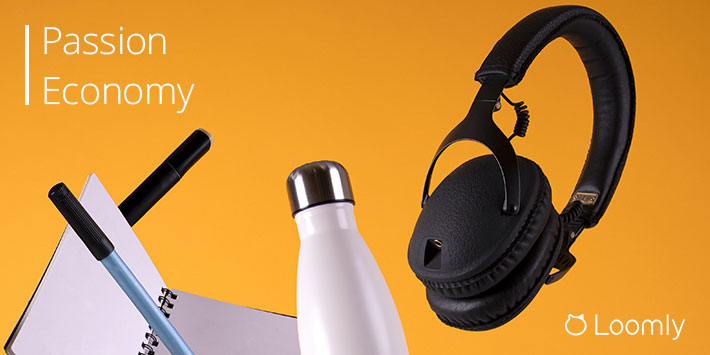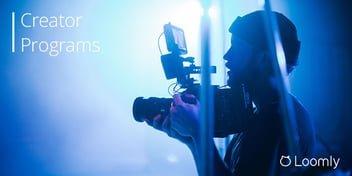The passion economy gives individuals the freedom to work when they want, from where they want, and according to Ji Lin, it’s the future of work.
It allows people to pursue their passions and positively change the world around them, provides a passive income, and makes the world a more rewarding and fulfilling place to be.
Sounds great! But why the sudden change and what does it mean for existing brands?
That’s what this guide is all about. Read on to learn more about the passion economy, the factors driving its boom, and why brands should pay attention.

Manage all your social media accounts in one place.
Craft, schedule, & auto-post content to all your social channels, then track analytics and manage interactions from a single, easy-to-use dashboard.
What is the Passion Economy?
The passion economy is a new way for individuals to monetize their skills. It allows freelancers and entrepreneurs to earn passive income and scale their businesses exponentially.
It also removes the constraints associated with the freelance “gig” economy. Instead of trading time for money and lowering the value of their skills to remain competitive, the passion economy lets creators scale their skills on a one-to-many basis.
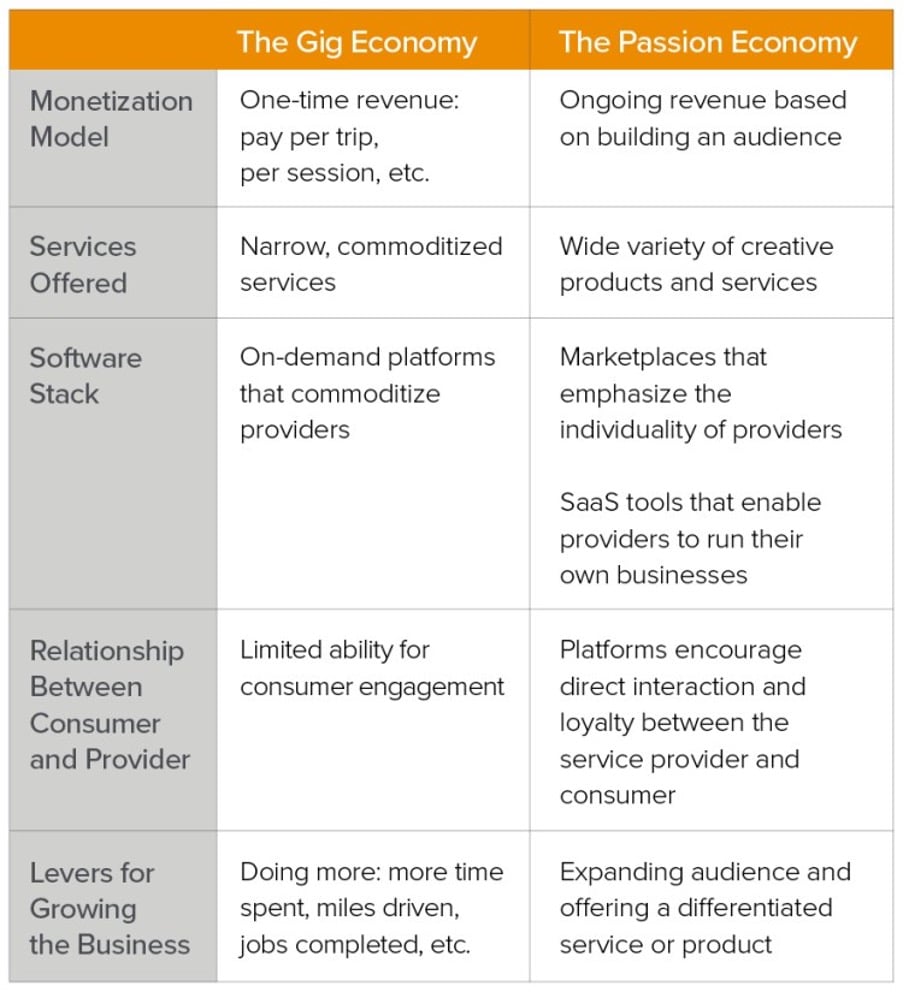
Source: a16z.com
Furthermore, the passion economy provides platforms for users to produce content that can be consumed at all times.
The main components of the passion economy include:
- Digital platforms that facilitate the creation, support, and growth of an individual’s products or services.
- Creators who use their skills, talents, and ideas to build successful businesses and brands.
- Niche audiences who find value in the creator’s products or services.
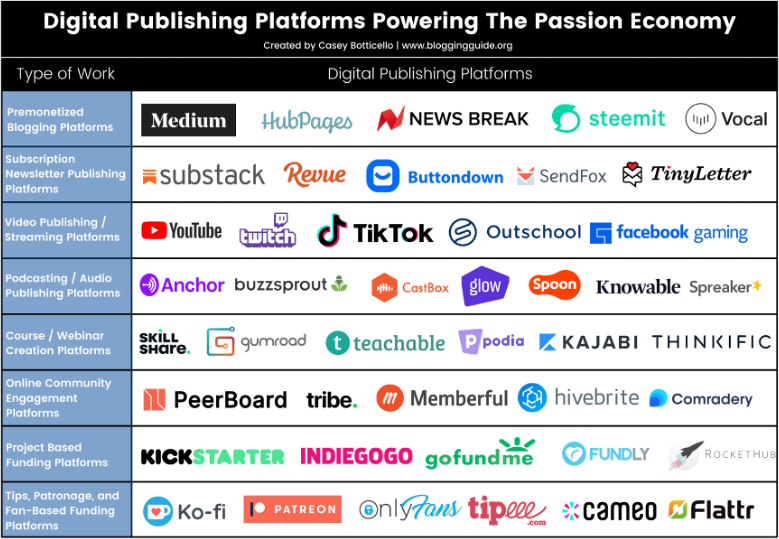
Source: Digital Marketing Lab
Some everyday examples of how people participate in the passion economy include:
- Creating and selling online courses, tutorials, and guides on platforms like Teachable and Thinkific.
- Creating paid newsletters on platforms like Substack and Revue.
- Self-publishing ebooks on Amazon and Gumroad.
- Podcasting on Anchor and Buzzsprout.
- Selling printable art and designs via Patreon.
The passion economy challenges the generalized and non-specific content of more prominent social media platforms with niche communities focused on creating and sharing content that resonates with individuals.
5 Factors Driving the Boom of the Passion Economy
Let’s take a look at five factors propelling the passion economy:
1. Influencer is the new dream job
When asked what their dream job is, over 86% of 13-to-38-year-olds said they wanted to be a social media influencer.
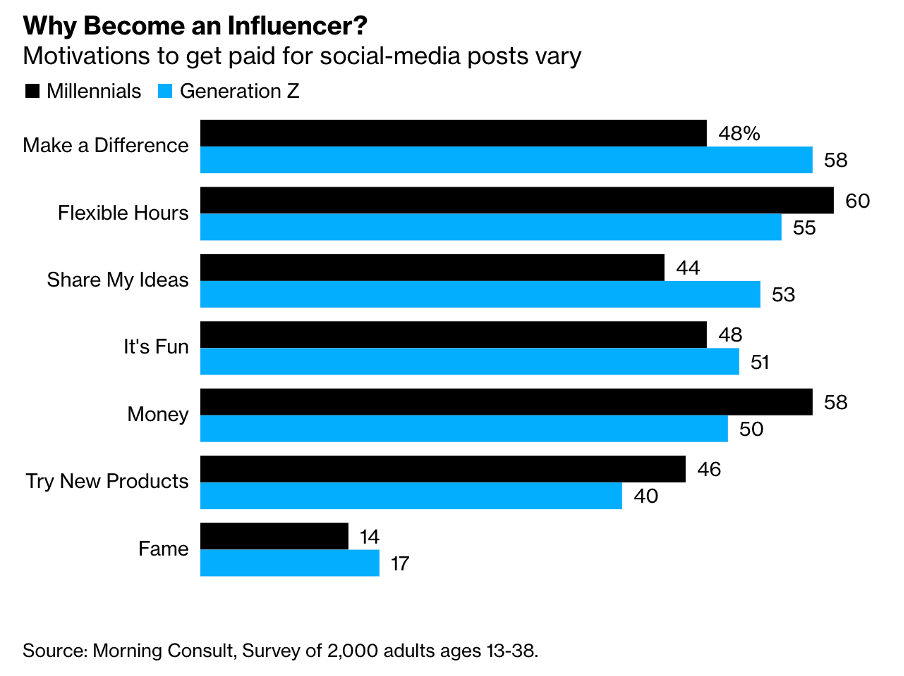
When probed on their motivations, Millennials said they were attracted to money and flexible hours, while Generation Z said they wanted to make a difference. Both generations already trust micro-influencers more than celebrities and athletes, and more than half have made a purchase based on a recommendation from someone in their feed.
Plus, 61% of the young Americans said they were already posting online about brands they like without receiving any compensation, so why not make it their dream job and get paid?
2. Creators programs are the new black
Creators programs, such as those from Clubhouse, TikTok, and Substack, help aspiring creators build their audiences, connect with brands, and perhaps most importantly, monetize their passion.
The Clubhouse Creator First accelerator program aims to support and equip emerging creators with the resources they need to bring their ideas and creativity to life.
Clubhouse will support the selected creators by sending them equipment (such as an iPhone, iRig, or AirPod Pros, if required), providing assistance in developing concepts, and matching them with relevant brands for sponsorship opportunities. Plus, they also get a guaranteed monthly stipend of at least $5,000.
The TikTok Creator Program – now called the TikTok Next Level program – is a premium-level membership that offers more support for creators, including tech support, analytics, early access, and the ability to connect with fellow creators.
- Tech Support – In general, TikTok doesn’t offer any “live support”. But the Next Level program offers ticketed support with a response time of 72 hours.
- Analytics – If you’re trying to make a living from TikTok, you’ll need analytics. The Next Level program includes a weekly insights package that provides audience data to help you refine your efforts.
- Early Access – as the name implies, you’ll get first access to any new functionality on TikTok.
- Creator Connections – TikTok hosts regular events for creators in the Next Level program to meet, share methodologies, and implement new ideas.
The Substack Fellowship for Independent Writers selects five writers who are already active on Substack to help them take their publications to the next level and set them up for long-term success with the subscription publishing model.
Those who get chosen for the three-month program receive a monthly stipend, as well as coaching and support from the Substack team and a group of experts. The writers also get access to Substack’s founders for product discussions, plus support on design, branding, publicity, and social media strategy.
Substack also plans to package the advice from the first batch of fellows and make it available to everyone on the platform.
3. Investors are backing the passion economy
Venture capitalists are investing significant sums into the passion economy. For instance:
- Patreon, the platform connecting creators with fans, announced $155 million in fresh funding at a $4 billion valuation.
- Audio platform Clubhouse is also said to be raising more money at a $4 billion valuation.
- Newsletter platform Substack raised $65 million at a $650 million valuation.
- Celebrity messaging app Cameo added $100 million at a valuation of more than $1 billion.
- Music distribution startup UnitedMasters secured $50 million in an Apple-led round.
- Social gaming platform Roblox, which paid nearly $329 million to game creators in 2020, received over $850 million in VC funding before going public in 2021.
4. There is an entire ecosystem of tools, infrastructure, and resources empowering creators
Check out this video from Patreon founder Jack Conte, as he shares what’s happening in the creative economy and why the future will be fantastic for creative people:
He describes a feedback loop – an entire ecosystem of tools, infrastructure, and resources – that’s empowering creators. What used to be disparate systems have become “lego-ized”, which leads to accessible, easy ways for creators to make money and build businesses.
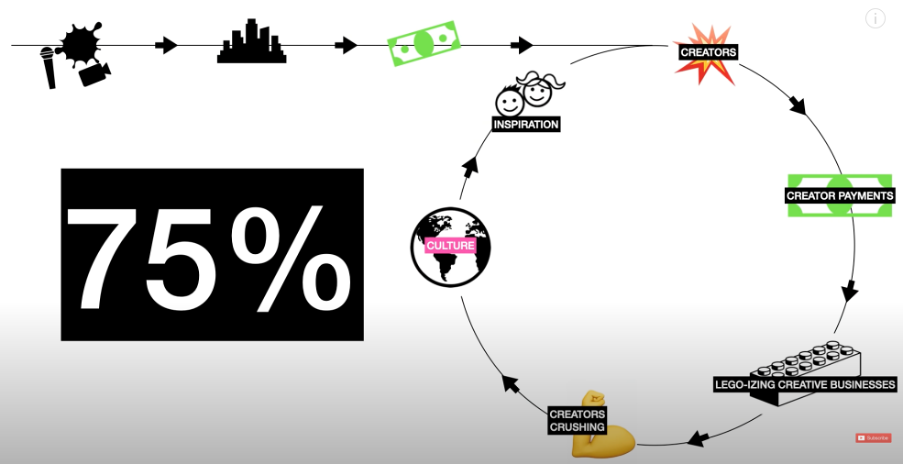
Jack says:
It’s about building your dream as a creative person.
Professional creativity becomes as normal as being a doctor or a lawyer. And it’s about to be financed and celebrated, so there’s no better time to be a creator.
5. NFTs are unveiling new revenue streams for creators
Non-fungible tokens (NFTs) are fueling the trend of creators monetizing directly with their fans.
Although creators will continue to use social platforms for building audiences, they can now use new methods, including NFTs and social tokens, to generate revenue.
Social tokens – also known as personal tokens, community coins, and creator coins – are decentralized and secured by blockchain and built on the same model as common cryptocurrencies like Bitcoin and Ether.
NFTs uniquely represent pieces of digital media such as art, videos, music, gifs, games, text, memes, and code. They offer fundamentally better economics for creators because they:
- Remove rent-seeking intermediaries – e.g. Substack takes a 10% cut of creators revenue.
- Enable granular price tiering – e.g. NBA Top Shot cards range from over $100K to a few dollars.
- Make users owners – e.g. customer acquisition costs are almost zero as there are no online ads or sales staff.
Why Brands Need to Pay Attention to the Passion Economy
There are two main reasons why brands need to take notice of the passion economy.
On the one hand, each new creator is a potential brand partner who can develop innovative, effective influencer marketing campaigns. As we’ve seen earlier, Influencers, especially micro-influencers, are well-respected by the younger generations.
Brands will need to rely on influencers more than advertising to generate brand awareness and revenue. In a recent influencer marketing study, the ROI of the blog posts alone (not including social promotion) was 11 times the ROI of banner ads after 12 months.
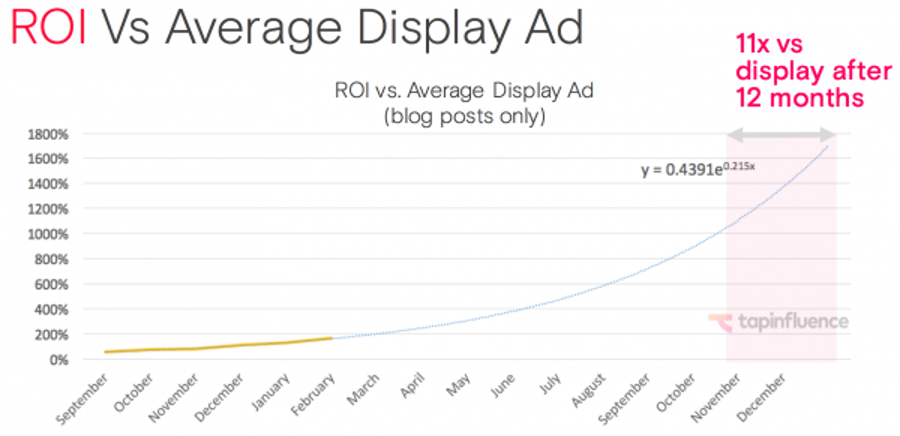
On the other hand, each new creator is a potential competitor to brands because as they grow their audience, they become their own brands.
As Hugo Amsellem says:
Audiences are the wind of the Internet Ocean. Leverage them, and you can sail anywhere.
Successful creators are transforming their audiences into empires. For example,
- Gamer PewDiePie has built a 25B+ views media empire.
- Shopify has built a billion-dollar DTC ecommerce platform.
- MrBeast burger launched a country-wide burger chain.
Using the Creator Lifecycle – attention, trust, commerce, ownership – there’s no limit to what creators can achieve with their audience:
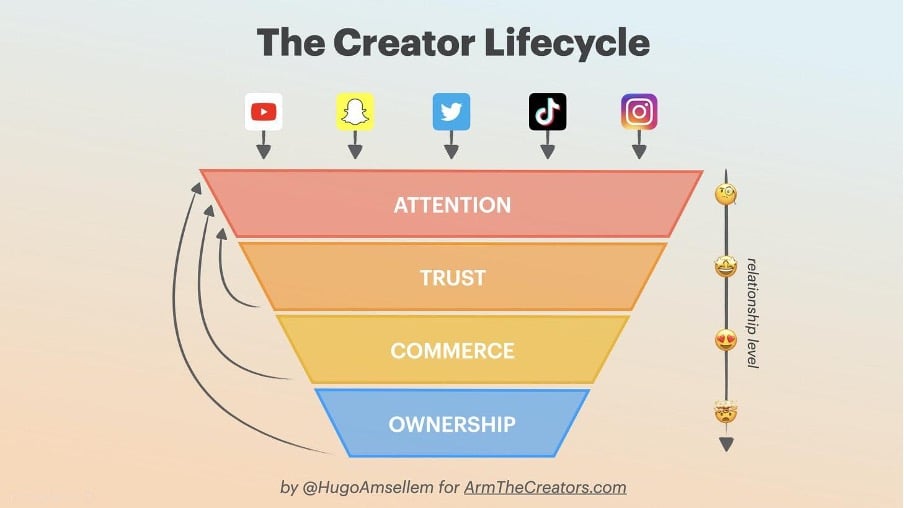
Source: Arm The Creators
The Passion Economy, in a Nutshell
The passion economy is the future of work. As more people use their creative skills to build niche communities, existing brands, including social networks, either have to adapt or flounder.
One thing’s for sure: this is the era of the creator equipped with an entire ecosystem of tools, infrastructure, and resources, ready to make money and build their own brands.
